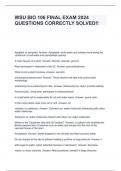Bio 106 Study guides, Class notes & Summaries
Looking for the best study guides, study notes and summaries about Bio 106? On this page you'll find 259 study documents about Bio 106.
Page 2 out of 259 results
Sort by
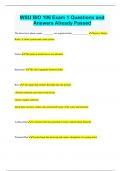
-
WSU BIO 106 Exam 1 Questions and Answers Already Passed
- Exam (elaborations) • 10 pages • 2024
- Available in package deal
-
- $9.99
- + learn more
WSU BIO 106 Exam 1 Questions and Answers Already Passed The three basic plant organs, ________, are organized into_____________. Leaves, Stems, Roots; A shoot system and a root system Nodes The point at which leaves are attached Internodes The stem segments between nodes Root -An organ that anchors the plant into the ground -Absorbs minerals and water from the tip -Stores organic nutrients -Root hairs increase surface area and absorb most of the water and minerals Axillary ...
WSU BIO 106 FINAL EXAM 2024 QUESTIONS CORRECTLY SOLVED!!
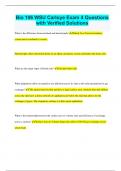
-
Bio 106 WSU Carloye Exam 4 Questions with Verified Solutions
- Exam (elaborations) • 11 pages • 2024
- Available in package deal
-
- $9.99
- + learn more
Bio 106 WSU Carloye Exam 4 Questions with Verified Solutions What is the difference between blood and hemolymph? Blood: In a Closed circulatory system and is confined to vessels. Hemolymph (AKA interstitial fluid): In an Open circulatory system and bathes the body cells. What are the major types of blood cells? red and white cells What adaptations allow an animal to use diffusion across its skin as the only mechanism for gas exchange? The animal must be thin and have a large sur...

-
WSU BIO 106 LBL Questions with 100% Correct Answers | Latest Version 2024 | Verified
- Exam (elaborations) • 12 pages • 2024
- Available in package deal
-
- $11.49
- + learn more
WSU BIO 106 LBL Questions with 100% Correct Answers | Latest Version 2024 | Verified
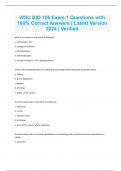
-
WSU BIO 106 Exam 1 Questions with 100% Correct Answers | Latest Version 2024 | Verified
- Exam (elaborations) • 28 pages • 2024
- Available in package deal
-
- $13.49
- + learn more
what is normally not a function of the root? a. anchoring in soil b. storage of nutrients c. photosynthesis d. water transport e. mineral transport - c. photosynthesis which of the following shoots are defined as horizontal shoots that grow along the surface a. stolons b. pneumatophores c. tendrils d. rhizomes e. bulbs - a. stolons the most outer layer of the plant root tissue is... a. epidermis b. cortex c. vascular tissue d. trichomes e. none of the above - a. epidermis

-
BIO 106 Exam 1 WSU
- Exam (elaborations) • 12 pages • 2024
- Available in package deal
-
- $9.99
- + learn more
BIO 106 Exam 1 WSU Which of the following statements is most likely to be true? - Water flows into the direction of the lowest water potential. Plasmolysis is a cellular loss of water. How can a cell potentially prevent this? - Increasing the cytoplasmic solute concentration What is correct about stomata movement control? Pick the Best. - Two of the above. Which tissue will an aphid quite specifically try to suck on? - Phloem The water potential in the root of a plant is higher ...
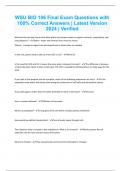
-
WSU BIO 106 Final Exam Questions with 100% Correct Answers | Latest Version 2024 | Verified
- Exam (elaborations) • 23 pages • 2024
- Available in package deal
-
- $13.49
- + learn more
What are the two key tissues that allow plants to transport water or organic nutrients, respectively, over long distances? - Xylem - water and minerals from roots to shoots . Phloem - transports sugars from photosynthesis to where they are needed In the root, plants need to take up more CO2 or O2? - More O2 Is the need for CO2 and O2 in leaves the same when compared to roots? - The difference is because of what the plant needs at that certain spot. The CO2 is needed for photosynthesis to ma...
WSU Carloye Bio 106 Exam 3 Questions and Answers (Latest Update 2024)

-
WSU BIO 106 PRACTICE EXAM
- Exam (elaborations) • 14 pages • 2024
- Available in package deal
-
- $9.99
- + learn more
WSU BIO 106 PRACTICE EXAM 4 The neuron: a) Has high internal concentrations of Na+ b) Generally has a simple shape with low surface area c) has dendrites that send signals to other neurons d) Has vesicles filled with neurotransmitter e) Has a membrane potential that is +50 mV at rest - d Which of the following is true about neurons: a) Intracellular fluid (inside the cell) - primary cation is Ca+, Na+ is low b) Extracellular fluid (outside the cell) - primary cation is K+, Na+ is lo...
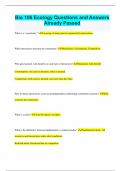
-
Bio 106 Ecology Questions and Answers Already Passed
- Exam (elaborations) • 7 pages • 2024
- Available in package deal
-
- $9.99
- + learn more
Bio 106 Ecology Questions and Answers Already Passed What is a "community"? A group of many species organized by interactions What interactions structure the community? Mutualism, Consumption, Competition Who gets harmed, who benefits in each type of interaction? Mutualism- both benefit Consumption- one species benefits, other is harmed Competition- both species harmed, one more than the other How do these interactions create an interdependence underlying community structure? ...

Study stress? For sellers on Stuvia, these are actually golden times. KA-CHING! Earn from your study resources too and start uploading now. Discover all about earning on Stuvia

